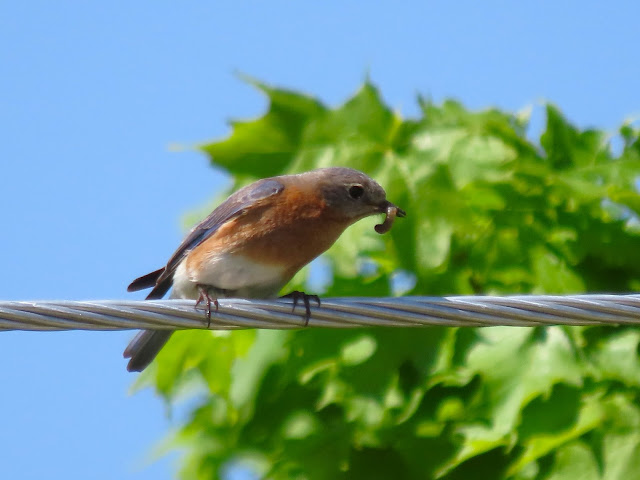We have been dropping by SpruceHaven quite frequently of late, and I'd like to share some of our sightings with you.
21 May, 2024
We observed several trees quite heavily infested with Maple Bladdergall Mite (Vasetes quadripes). They are, perversely, quite attractive and appear to do little harm to the tree.
An American Robin (Turdus migratorius) was occupied with incubation, and we made sure not to disturb her.
Eastern Bluebirds (Sialis sialia) were quick on the uptake when we first installed suitable nest boxes for them, but seeing the birds is not always easy. Today was one of those days when they cooperated beautifully.
Song Sparrows (Melospiza melodia) sing frequently and leave little doubt as to their identification.
Dame's Rocket (Hesperis matronalis) is an introduced species that has spread prolifically; it is beautiful and here to stay, I'm afraid.
Flycatchers in general are suffering from a severe decline in their insect prey, but this Eastern Kingbird (Tyrannus tyrannus) seemed to be feeding well when we observed it sallying forth to capture aerial prey.
I doubt that anyone has ever conducted a survey to determine the world's most well known butterfly, but I suspect that Monarch (Danaus plexippus) would capture the prize.
Their epic migration to Mexico rivals Icelandic legend, yet sadly their small overwintering sites in the mountains of central Mexico are threatened by an expanding human presence and illegal avocado farming.
Tree Swallows (Tachycineta bicolor) appear to be having an excellent breeding season this year, with many nest boxes harbouring eggs or young.
I know several people for whom the return of the Baltimore Oriole (Icterus galbula) each spring is a major highlight on their annual calendar.
An Eastern Tailed Blue (Cupido comyntas) pleased us very much.
When it was time to leave a cheery Yellow Pond Lily (Nuphar lutea) bid us a fond farewell, but only after extracting a solemn promise to return.
16 June, 2024
Who would not agree that to be greeted by a Common Ringlet (Coenonympha california) is an excellent way to start a walk? Such was our good fortune.
Margined Calligrapher (Toxomerus marginatus) is a very handsome little fly, no doubt welcomed by gardeners who take the time to get to know them, for they consume aphids and small caterpillars.
Virginia Ctenucha (Ctenucha virginica) is one of our most common diurnal moths and a real treat to see.
Many Tree Swallows are about to leave the nest and enter a competitive world without parents to care for them and cater to their every need.
It is understandable that they are initially a little reluctant to leave the safety of the nest, but leave they must and one by one they make their maiden flight.
One sibling follows another and they quickly learn to soar on the wind, propelled by genetic encoding that will also guide them on their southbound migration, and return them safely next spring.
Meantime, some adults are already incubating second clutches.
I could not begin to count the times I have witnessed this phenomenon but it never ceases to fill me with wonder; if anything more so each year.
A Northern Crescent (Phyciodes cocyta) showed both underwing and upperwing.
Cinquefoils (genus Potentilla) hug the ground like strawberries; most have yellow flowers; all are beautiful.
A female Red-winged Blackbird (Agelaius phoeniceus) looks so different from the male that early observers considered them different species - until they saw them in copula, that is!
Skippers (family Hesperidae) can be a little difficult to identify, and time invested in their study is time well spent. This is an Essex Skipper (Thymelicus lineola), formerly known as European Skipper.
Black-eyed Susan (Rudbeckia hirta), before becoming the familiar flower, looks like it might be at home alongside Triffids!
You probably know that many insects have not been assigned common names, as is the case here. It is called Gymnoclytia occidua, a species of tachnid fly.
Purple Crown Vetch (Securigera varia) seems to be blooming everywhere - and very welcome it is, too.
Oxeye Daisies (Leucanthemum vulgare) have been co-opted by gardeners as a domestic floral addition to their display, but it's great to see them doing well in their wild state.
The wonderful world of taxonomy is ever bubbling and fermenting, and with the sophistication now possible by molecular analysis, changes in classification are to be expected. Thus, I am happy to present a White Admiral x Red Spotted Purple (Limentis arthemis arthemis x astyanax)! I must confess that I had to have this hybrid form pointed out to me. I had been quite happy with Limentis arthemis ssp astyanax.
Common Ninebark (Physocarpus opulifolius) is easy by comparison.
Damselflies in the Bluet grouping can be difficult to identify from a picture. I am confident this species is in the genus Enallagma but I'm not prepared to commit myself much beyond that.
We confirmed three active House Wren (Troglodytes aedon) nests in our nest boxes, two with young - I wasn't quite tall enough to check the third!
As best either Miriam or I can recall we have not previously seen Orange Hawkweed (Pilosella aurantiaca) in Ontario.
Wasps in the family Crabronidae are affectionately known as Square-headed Wasps and this extraordinarily handsome species is in the genus Ectemnius.




































































Thank you and Miriam so much for taking me/us on yet more wonderful outings.
ReplyDeleteOur pleasure, Sue.
DeleteWonderful photos, as always. I love those little tree swallowa, and hope they survive their life on their own. Here we have been warned about Asian hornets, which are on the increase and therfore endanger our bees. If we see one we have to report it. I have bluebirds on my blog today, too! Hugs, Valerie xxxxxxx
ReplyDeleteSome of those little swallows will not make it, Valerie, and even those that do are going to have a hard time when confronted with declining insect biomass, their essential source of food.
DeleteFantastic photos, David. Miriam is an excellent photographer. And the Maple Bladdergall Mite actually look pretty nice on the leaves.
ReplyDelete...David, thanks for this fabulous collection, nothing misses your eye!
ReplyDeleteBeautiful series of photos David.
ReplyDeleteI really love the Eastern Bluebirds and the Tree Swallows.
Also many beautiful plants and butterflies.
I think photos 25 and 26 of the swallow from the nest box are very cute.
I enjoyed your photos.
Greetings Irma
Love the Tree Swallows. We saw Bank Swallows at the other said of Bedeque Bay last week but couldn’t get any photos. They are safe in those banks which is great!
ReplyDeleteThank you for sharing all the beautiful photos of butterflies, birds and flowers. The Tree Swallows have a very lovely color, David. I love to see the Eastern Bluebirds too. It's a very beautiful bird. Hugs and kisses, Marit
ReplyDeletegorgeous photos and the baby swallows are adorable, love the LOOK on the face of the first one... even the insects are beautiful, bees/wasps I mean. I like the chickadees, so cute.. there is not a single photo that I can find fault with
ReplyDeleteHi David.
ReplyDeleteSo much beauty to see.
Nice birds
Beautiful butterflies and those Barn Swallows are beautiful.
Greetings from Patricia
Thanks for taking me along on your nature walk. Always a pleasure!
ReplyDeleteGreat collection of photos David
ReplyDeleteI wonderful array of photos, as usual. All lovely--even the wasps I'm scared of--lol! ;)
ReplyDeleteWonderful photos! I especially love seeing the photos of the birds we don't see here, the bluebirds and orioles.
ReplyDeleteI am coming back to your blog after a long time. What a delightful array of observations here!
ReplyDeleteThe Maple Bladdergall Mite does add an interesting touch to the trees, almost like nature's unique artwork. The Black-capped Chickadee always brings a smile with its cheery presence.
Song Sparrows are indeed quite vocal and unmistakable. Tree Swallows having a good breeding season is indeed heartening news.
Thank you for sharing these wonderful moments from your nature walk. It's always a joy to see such biodiversity and the care with which you observe it.
Great to have you stop by again, Pradeep. I will swing over to your blog right away.
DeleteAmazing pictures David !
ReplyDeleteBeautiful birds, insects and flowers ! They need each others...so do we !
Have a shinny day !
Anna
Thanks for sharing the beauty, Miriam and you make a great team.
ReplyDeleteIt also seems like a world of butterflies.
ReplyDeleteLástima de esa enfermedad, que está atacando al arbol.
ReplyDeleteMe han encantado, todas las fotografías de tu reportaje.
Saludos en una tarde de verano.
Hari OM
ReplyDeleteMy word, every single photo provides a gem! What a joy... YAM xx
So many wonderful images! Thanks to Miriam for taking them and to you for sharing them. And I agree that the sumac image is perfect!
ReplyDeleteGreat photos. Monarch (Danaus plexippus) is one of the most beautiful butterflies.
ReplyDeleteSo many interesting things on your walks, David, birds, blooms, insects butterflies. I was curious after reading your comment that the monarch might be the most well observed. SO curious if it would also be the most widespread and amazed to read that honor goes to the painted lady butterfly, which can be spotted on six continents and all over North America. SO now, thanks to your comment I have increased my knowledge as well.
ReplyDeleteThe young tree swallows were a familiar site as we once had they build a nest on our front porch.
No one will be surprised that you have done your research, Dorothy. You are quite correct that Painted Lady is the most cosmopolitan, but nothing seems to fuel the imagination like the migration of the Monarch. TV documentaries have been devoted to it.
DeleteIt just amazes me that you see such variety on your walks. You both have certainly trained your eyes well to see what most of us miss. Your photos are such a treat, David.
ReplyDeleteLovely flora and fauna. Bluebirds and swallows and oriels add to the color!
ReplyDeleteYou see so many organisms on your walks. Isn't it amazing how many things you can find if you take the time to look? hugs-Erika
ReplyDeleteIt’s a combination of learning where to look and how to look. Patience doesn’t hurt either.
DeleteHi dear friends! what pleasant photographs, it looks like a storybook setting! the golden and hot summer,
ReplyDeleteand blond hay,
beautiful nights, long days,
with fireflies and starry nights
what a divine ride!
It inspires me to do poetry (although it has a dysfunctional rhyme jaja lol)
the valley
it's full of gold
the cicadas
shout in chorus,
blue birds, butterflies and flowers all happy and radiant in harmony in the meadows .
thank you very much for sharing so much beauty, dear friends Miriam and David.
Have a nice night.
You are amazing!
DeleteLovely photos and I do like the Tree Swallow photo and bird of course.
ReplyDeleteHello David,
ReplyDeleteWonderful outing and beautiful captures of the birds, butterflies and the flowers.
Take care, have a great day!
Beautiful serie photos. I like the swallows. I don't see many swallows this year. Have a nice day.
ReplyDeleteMarvelous photos of those small birds that disagree on leaving the safety of the nest.
ReplyDeleteSo many wonders. Oh my gosh those sweet babies. Our blue bird babies flew the coop quite sometime ago. I noticed Mr. and Mrs. were sitting on the fence beside the house and thought maybe they were waiting for us to clean it out, so I asked the HH to take care of that. He went out there and found out they'd already had babies again:)
ReplyDeleteIsn't it amazing that those fragile looking Monarchs can make such a long journey?
Beautiful nature photo
ReplyDeleteUn gran reportaje de los que me encantan. Gracias por todo lo que nos has traído. Abrazos.
ReplyDeleteHello David,
ReplyDeletethe pictures where the insects are photographed against the green background, it fits together perfectly.
Greetings Frank
Hello David and Miriam, thank you for your great post with the wonderful photos taken by Miriam. Nature is so abundant in your part of the world with all the different birds and insects. They all have amazing colours too. But this time the Tree Swallows are my favourite. We do not have this kind of Swallows in our part of the world. To bad their habitat in Mexico is under treath.
ReplyDeleteTake care and all the best,
Roos
What a great place to visit, David. Sorry this has taken so long but I can only comment on your blog on my computer.
ReplyDeleteWonderful series. I especially like the barn swallows. They are so pretty. I can remember when I used to use a riding mower Hammaker used to dive bomb me trying to get the insects that I was stirring up. I also remember that they were also guilty of robbing bird houses of their nests and whatever was in there with them. Not a nice trait... Love the pictures!
I did not know that carpenter bees came that small. I have seen them but was not aware of what kind of bee it was.
Superb photos Miriam!!!
Wishing you both a wonderful weekend. Hugs
Amazing photos!
ReplyDeleteThe birds really are like posing for your lens!!
Loved the picture of the Eastern Bluebirds and all the critters you've captured!
Thank you very much!!
It is wonderful to see all your photos today, and please thank Miriam also. I have never heard of the Maple Bladdergall Mite. Always an education, always learning something new here. Thank you very much!
ReplyDeleteThis is an excellent collection of photos. The swallows leaving their nest is a sweet photo.
ReplyDeleteThe tree swallows are so beautiful. Those little mites amazed me -- I thought they were red berries at first!
ReplyDeleteWhat a wonderful variety of 'critters'! I love the Monarch and hope to see them soon here. I see a lot of swallows but they rarely perch for photos!
ReplyDeleteSo many lovely photographs, great sightings.
ReplyDeleteAll the best Jan
ReplyDeleteWhat a great diversity of birds, insects and plants. You can see that nature there is in all its splendor. Very nice images accompanied by an excellent story, as always. A big hug
Again so many beautiful photos! Miriam is a real master (please let her know, David). The return of the Hooded Oriole is a highlight for me as well, so I can completely understand how someone feels about the Baltimore Oriole. I'm a bit jealous about all the Eastern Bluebird sightings - I haven't seen that many Western Bluebirds this year, but this might also be because I wasn't able to get out that much like I usually do. Instead we could witness a pair of Mourning Doves raising their family in our garden (I just wrote about it on my blog) and I feel so richly gifted that we were allowed to see this. It definitely was our June highlight. Hugs - Carola
ReplyDelete